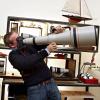-
Similar Content
-
Posts
-
It is really easy to find out if the wifi is on. Your computer or tablet or cell phone will have a network settings dealing with wifi, bluetooth, ethernet or “other”. Open that up and go into the section for wifi, and take note of which networks are listed. Turn on the camera and keep watching the list of networks. If your camera’s wifi is turned on, a new network should suddenly show up in your computer/tablet/phone’s network listings. Now go into the camera’s menus and start a wireless connection (the x-app or camera remote app can help you with this). You should see a network show up now. It is not hidden because it has to be visible so that your computer/tablet/phone can join the camera’s network to transfer images. Turn the camera off and that network should disappear. Turn the camera back on and see what happens.
-
Sweet Creek Falls, Oregon. X-H1, Viltrox 13mm F1.4, Acros.
Welcome, dear visitor! As registered member you'd see an image here…
Simply register for free here – We are always happy to welcome new members!
-
I think my Fuji 150-600 F8 is a brilliant wildlife lens in terms of sharpness, portability and value but the small aperture does cause issues at the start and end of the day - even pushing the ISO as far as I dare, I can see shutter speed down to 1/25s - stabilisation isn't an issue but asking a deer to stand still for that is too much! In the same situation, an F4 would give 1/100s so the difference to the success rate would be phenomenal... and that's without the other improvements like shallower depth of field. I also find that the Fuji's subject detect AF gets pretty iffy in low light - I keep updating to the latest firmware but it doesn't seem to get any better. I was originally looking at the Nikon 500mm F4 E but good examples secondhand are still reasonably expensive but like-for-like Sigma lenses are around half the price. Reviews I have read suggest that they are as good optically, AF performance and IS-wise but you gain a few hundred grams of weight (but less than the older Nikon model). For a couple of grand, I can live with that. Does anyone have any experience mounting one on an XH2S? What about with the 1.4 teleconverter? It feels like that is pushing it anyway - hefty lens + TC + Fringer all sounds a bit...wobbly? It is on the Fringer approved list but I am wary about AF speed in particular. I had also considered looking for a used Nikon 400mm F2.8, which would be even faster (and heavier) and could couple with a TC to give 560mm F4 but again, it is that lens+TC+Fringer combination that worries me as being just too many links in the chain. Of course, what I really want is a native Fuji prime but that doesn't seem to be on the horizon - and if you look at what Nikon and Sony are doing, if Fuji do ever bring out a 500mm prime, it will probably be a small, light and cheapish F5.6, which is only 2/3 stop better than my zoom at the same focal length. Any thoughts anyone?
-
The Amazon link is an annoying feature of this forum - its automatic and is applied to every post for advertising purposes. My question was - how do you know the camera wi-fi is on and requires turning off? I would have thought this would just use up the battery for no purpose if you aren't specifically using a function that requires wi-fi.
-
By anonsailor · Posted
I've made a point to push Angelbird memory products as they are the best performance cards you can get, The sustained write speed is important.
-



Recommended Posts
Join the conversation
You can post now and register later. If you have an account, sign in now to post with your account.
Note: Your post will require moderator approval before it will be visible.